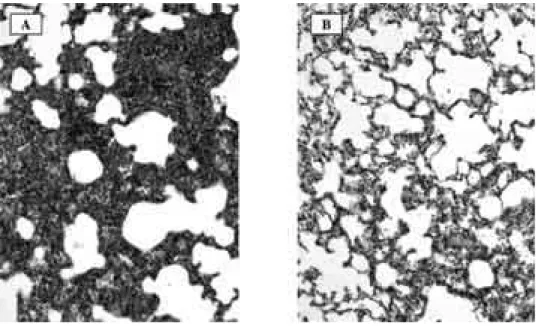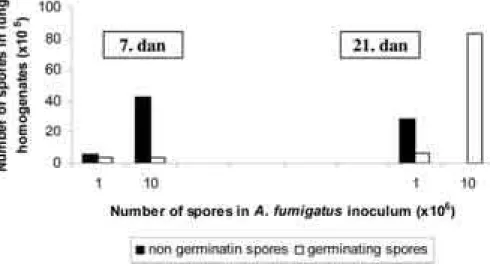Zbornik Matice srpske za prirodne nauke / Proc. Nat. Sci., Matica Srpska Novi Sad,
¥113, 243—247, 2007
UDC 599.323.4:616.24-092]:579.6
J e l e n a S. Ÿ i v a n o v i ã1, M a r i n a D. S o k o v i ã1,
J a s m i n a M. G l a m o å l i j a1, L i d i j a D. Z o l o t a r e v s k i3, M i l e n a V. K a t a r a n o v s k i1 , 2,
D r a g a n S. K a t a r a n o v s k i1 , 2
1 Institute for Biological Research “Siniša Stankoviã",
Bulevar despota Stefana 142, Belgrade, Serbia
2 Faculty of Biology, University of Belgrade, Studentski trg 16, Belgrade, Serbia 3 Military Medical Academy, Crnotravska 17, Belgrade, Serbia
CHARACTERISTICS OF LOCAL PULMONARY
RESPONSE FOLLOWING INTRANASAL APPLICATION
OF
ASPERGILLUS FUMIGATUS
CONIDIA
ABSTRACT: In this study, histopathology of local pulmonary response following in-tranasal inoculation of different doses of Aspergillus fumigatus conidia in laboratory rats was evaluated. Development of response was evaluated on days seven and twenty one, following conidia inoculation by cell infiltration and by presence ofA. fumigatusconidia in homogenates of lung tissue. Total and differential peripheral blood leukocyte counts and state of leukocyte adhesion/aggregation were monitored to estimate the presence of systemic response in infected individuals. Mycological examination revealed the presence of conidia in lung tissue homogenates of infected animals, with high number of non-germinating spo-res on day twenty one, following the inoculation of lower conidia dose. Histopathological examination revealed the presence of lymphocytes perivascularly and in vascular lumen in the lungs. Presented data demonstrate pulmonary immune response followingA. fumigatus
conidia administration.
KEY WORDS:Aspergillus fumigatus, histopatology, laboratory rats, lung homogena-tes, lungs, lymphocytes
INTRODUCTION
inha-lation and reach distal alveoli (the lungs are the most common site of infec-tion).
Pulmonary aspergillosis is the most common and involves allergic bron-chopulmonary aspergillosis, aspergilloma and invasive pulmonary aspergillosis (S h i b u y a, K. et al., 2004). As manifestations of the infection depend on host's immune response, the increase in numbers of immunocompromised and susceptible hosts fueled interest in aspergillosis. The interaction between weak-ened defense mechanisms and pathogenic conidia of A. fumigatus cause pul-monary lesions. A. fumigatus is not pathogenic in immunocompetent indivi-duals, where innate immunity is considered as the main defense against this fungus (R o m a n i, L., 2004).
In almost all investigations of A. fumigatus infections and aspergillosis, immunocompromised/immune suppressed animals were used. The aim of this study is to get the initial data about local host lung immune response in a mo-del of experimental pulmonary infection in apparently healthy, immunocompe-tent rats. With this aim, local pulmonary response to intranasal inoculation of A. fumigatus conidia was evaluated by histological evaluation and by determi-ning the number of germinating spores in lung tissue homogenates. The state of peripheral blood leukocytes was evaluated to monitor the presence of syste-mic response.
MATERIALS AND METODS
Conventionally housed Dark Agouti (DA) male rats, bred at the Institute for Biological Research “Siniša Stankoviã" were used. Animal treatment has been carried out in adherence with the Ethical Comittee of Institute for Biolo-gical Research “Siniša Stankoviã".
Human isolate A. fumigatus Fresenius (Institute of Public Health of Ser-bia “Dr Milan Jovanoviã Batut") was subcultured on standard mycology slant. Inoculum was prepared by flooding the surface of agar slants with sterile 0,85% of NaCl/0,1% of Tween 80. The suspension containing 106 and 107
co-nidia was applied intranasally, which reflects the natural route of Aspergillus infection in humans. The animals were assigned to two groups and sacrificed on days 7 and 21, following the inoculation.
Blood was collected (in citrate buffer 1:5 as anticoagulant) for counting peripheral blood leukocytes and leukocyte adhesion/aggregation assay (LAA). Cell counts were performed by differentiating 500 cells from blood smears stained with May-Grünwald-Giemsa.
Statistical evaluation of the data was performed using the Student'st-test. P values less than 0.05 were considered significant.
RESULTS
In this study, histological data revealed the presence of local pulmonary response 7 days after the inoculation at both doses: predominance of lympho-cytes perivascularly and in vascular lumen with increased bronchial secretion and tickened intersticium. No histologically evident changes were noted 21 days following the inoculation. Histopathological changes in lungs were pre-sented in Figure 1.
Application of A. fumigatus led to increased, but not statistically signifi-cant dose dependent on peripheral blood leukocyte activity (adhesion and ag-gregation) 7 days following the inoculation. No such changes were noted on day 21 following the infection. There were no differences in total and differen-tial peripheral blood leukocyte numbers between the control and the inoculated animals.
Mycological evaluation of lung homogenates documented the presence of both germinating and non-germinating spores of A. fumigatus in all rats, excluding the controls. On day seven, significant number of non-germinating spores was noted at both applied doses of conidia (Figure 2). On day 21, num-bers of non-germinating conidia increased further in group of animals which received 106conidia, while rise in germinating spores was noted in individuals
challenged with 107 conidia.
Fig. 1 — Histological picture of lungs from rats following application of 107 spores of
DISCUSSION
The increased number of non-germinating spores, on day seven, in lung homogenates at both conidia doses, and on day 21 at lower dose, could be explained by the presence of lymphocytes in cell infiltrate in lungs and their activity in situ. The presence of increased number of germinating conidia at higher dose on day 21 reflects, presumably, the capacity of small fraction of spores to germinate later in lung microenvironment. Investigation of possibility to over-ride local immune mechanisms deserves future attention.
Although no quantitative changes were noted in peripheral blood leu-kocytes, qualitative changes were noted. Increased state of leukocyte aggrega-tion/adhesion (LAA) suggest that local leukocyte lung response was accompa-nied by systemic response as well.
CONCLUSION
The presented data demonstrated histologically evident lung immune re-sponse following intranasal A. fumigatus conidia inoculation. This response is a possible mechanism of decreased numbers of germinating conidia at lower applied conidia dose.
ACKNOWLEDGEMENTS
This study was supported by the Ministry of Science and Environmental protection, Grant# 143038
REFERENCES
D e n n i n g, W. David (1998): Invasive Aspergillosis, Clinical Infectious Diseases 26: 781—805.
L a t g e, J. P. (1999): Aspergillus fumigatus and aspergillosis, Clin Microbiol Rev 12(2): 310—350.
R o m a n i, L. (2004):Immunity to fungal infections, Nature Rev Immunol 4: 11—23. S h i b u y a, K., A n d o, T., H a s e g a w a, C., W a k a y a m a, M., H a m a t a n i, S.,
H a t o r i, T., N a g a y a m a, T., N o n a k a, H. (2004): Pathophysiology of
pul-monary aspergillosis, J Infect Chemother 10: 138—145.
T a r r a n d, J. J., H a n, X. Y., K o n t o y i a n n i s, D. P., M a y, G. S. (2004): Asper-gillus hyphae in infected tissue: Evidence of physiologic adaptation and effect on
culture recovery, J Clin Microbiol 43(1): 382—386.
KARAKTERISTIKE LOKALNOG ODGOVORA U PLUÃIMA PACOVA NAKON INTRANAZALNE APLIKACIJE KONIDIJA
ASPERGILLUS FUMIGATUS
Jelena S. Ÿivanoviã1, Marina D. Sokoviã1,
Jasmina M. Glamoålija1, Lidija D. Zolotarevski3,
Milena V. Kataranovski1, 2, Dragan S. Kataranovski1, 2 1 Institut za biološka istraÿivawa „Siniša Stankoviã",
Bulevar despota Stefana 142, Beograd, Srbija
2 Fakultet za biologiju, Univerzitet u Beogradu,
Studentski trg 16, Beograd, Srbija
3 Vojno-medicinska akademija, Crnotravska 17, Beograd, Srbija
Rezime
Aspergillus fumigatusje oportunistiåka gqiva koja najåešãe dovodi do

